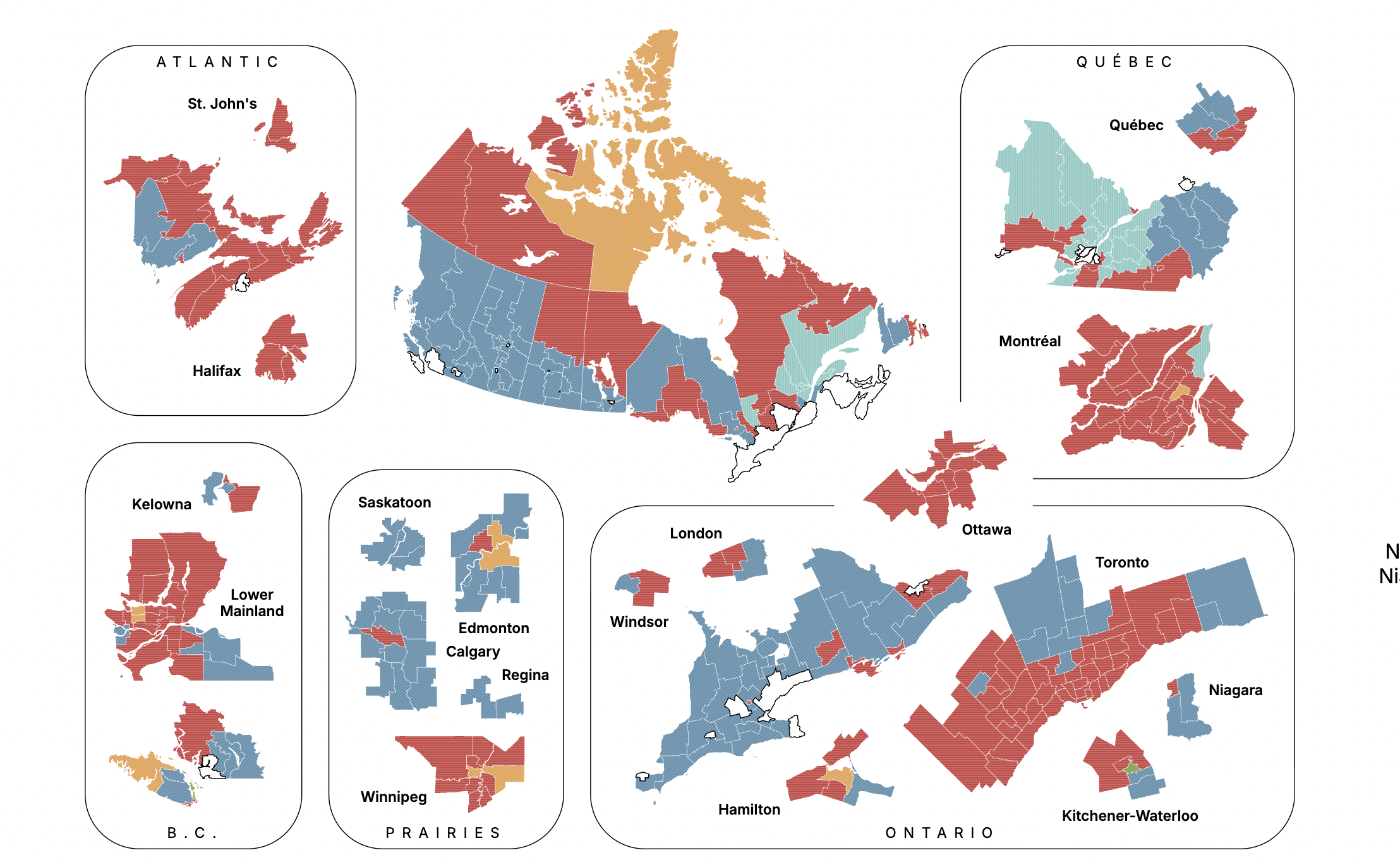Canadian Federal Election Projection Map September 2025


Marcus Rodriguez
Historical Geography Expert
Marcus Rodriguez specializes in historical cartography and geographic data analysis. With a background in both history and geography, he brings unique...
Geographic Analysis
What This Map Shows
The "Canadian Federal Election Projection - September 14, 2025" map provides a detailed forecast of the anticipated outcomes for the upcoming federal election in Canada. Based on current polling data, the map illustrates the projected percentage of votes and the number of seats each political party is expected to secure. The Liberal Party is projected to lead with 44% of the popular vote, translating into an estimated 172 seats, thus indicating a potential majority government. The Conservative Party follows closely with 39% and 134 seats. The New Democratic Party (NDP) is forecasted to garner 8% of the votes with 10 seats, while the Bloc Québécois and the Green Party are projected to receive 7% (25 seats) and 1% (2 seats) respectively. This visualization not only highlights the distribution of political power across Canada but also provides insight into the shifting political landscape leading up to the election.
Deep Dive into Canadian Political Geography
Understanding the projected electoral outcomes requires a closer examination of Canada’s political geography. The country’s vast expanse and diverse population contribute to a complex electoral system where regional identities significantly influence voting patterns. For instance, the Liberal Party's substantial projected support indicates a strong foothold in urban centers, particularly in provinces like Ontario and British Columbia, where a significant portion of the population resides.
Interestingly, have you ever wondered why urban areas tend to favor the Liberals? Factors such as higher diversity, educational attainment, and progressive social policies resonate more with urban voters, leading to a stronger Liberal presence. Conversely, the Conservative Party tends to perform well in rural regions and areas with more traditional values, particularly in the Prairies and parts of Atlantic Canada. This dichotomy highlights the importance of geographical context in understanding electoral projections.
Demographically, Canada is a mosaic of cultures, languages, and socioeconomic backgrounds. The Liberal Party's appeal to multiculturalism and inclusive policies is particularly attractive to immigrant populations, which are predominantly located in urban centers. Meanwhile, the NDP's lower projected share of the vote may reflect challenges in connecting with working-class voters outside of metropolitan areas, particularly in regions where industry and resource extraction dominate the economy.
The electoral system itself is another critical aspect to consider. Canada employs a first-past-the-post system, which means that the candidate with the most votes in a riding wins, regardless of whether they achieve an outright majority. This can lead to scenarios where a party can secure a majority of seats without a corresponding majority of the popular vote, as seen in past elections. The projected outcomes for the 2025 election could highlight these systemic anomalies, especially with the Liberals potentially winning a majority with less than half of the popular vote.
Regional Analysis
The map illustrates distinct regional voting patterns that are crucial for understanding the projected election results. In Ontario, the Liberal Party is poised to capture a significant number of seats, bolstered by strong support in urban areas like Toronto. Conversely, the Conservatives are expected to perform well in the suburban and rural regions surrounding the city, reflecting a divide that has been characteristic of recent elections.
Moving to Quebec, the Bloc Québécois appears set to maintain its influence with projected results indicating 25 seats. This reflects the unique political landscape of Quebec, where regional identity and language play a crucial role in shaping voter preferences. Interestingly, the presence of the Bloc also complicates the dynamics between the Liberals and Conservatives, as they vie for a limited pool of votes in the province.
In the West, the Conservative Party is expected to dominate, particularly in Alberta and Saskatchewan, where economic concerns related to the oil and gas industry resonate strongly with the electorate. The NDP, while marginally projected to gain a foothold, faces challenges in appealing to voters who may prioritize economic stability over progressive social policies.
Significance and Impact
The significance of the 2025 Canadian Federal Election projections cannot be understated. With the potential for a Liberal majority government, the political landscape may shift towards more progressive policies, particularly in areas such as climate change, social equity, and immigration reform. The implications of these policies will extend beyond the election itself, impacting Canadian society on multiple fronts, from economic growth to social cohesion.
Moreover, as Canada grapples with ongoing challenges such as climate change and economic recovery from the pandemic, the election results could dictate the direction of national policy for years to come. Current trends suggest a growing emphasis on environmental issues, which may further influence voter behavior, especially among younger demographics who prioritize sustainability.
In conclusion, the "Canadian Federal Election Projection - September 14, 2025" map not only serves as a visual representation of anticipated electoral outcomes but also opens a window into the complexities of Canadian political geography. Understanding these dynamics is crucial for anyone interested in the future of Canadian governance and society.
Visualization Details
- Published
- September 14, 2025
- Views
- 74
Comments
Loading comments...